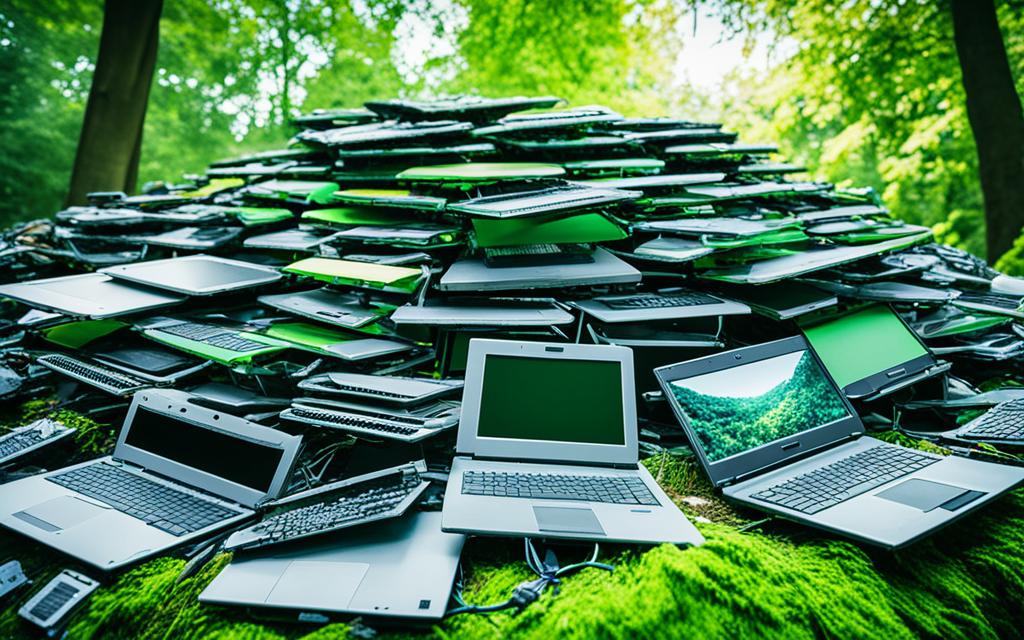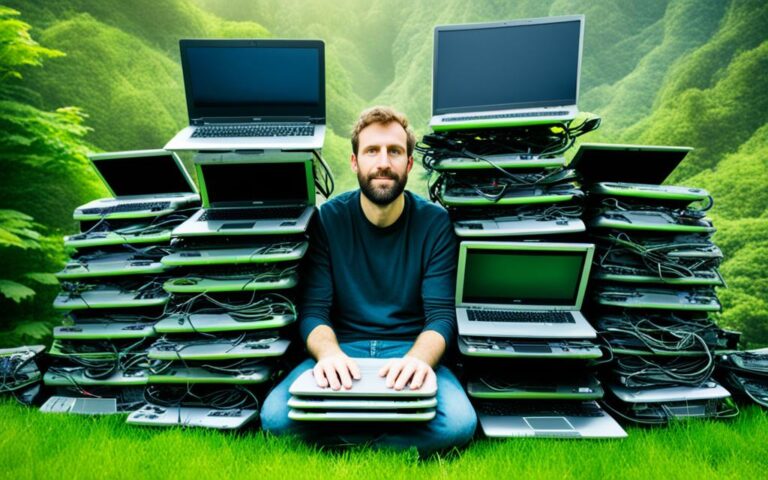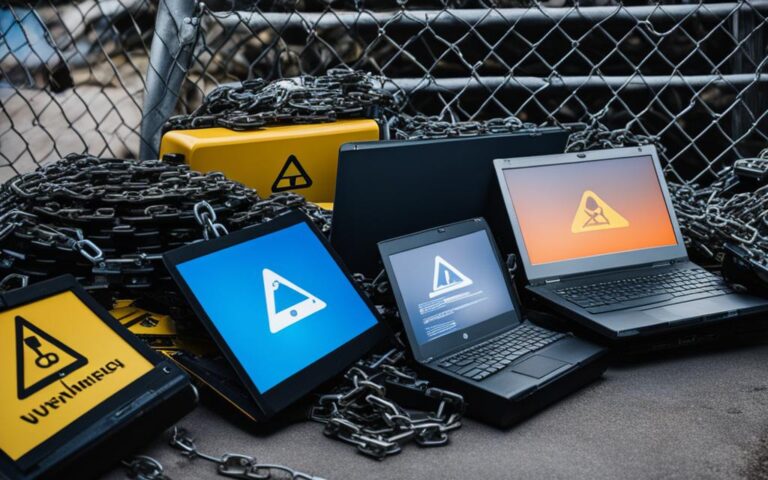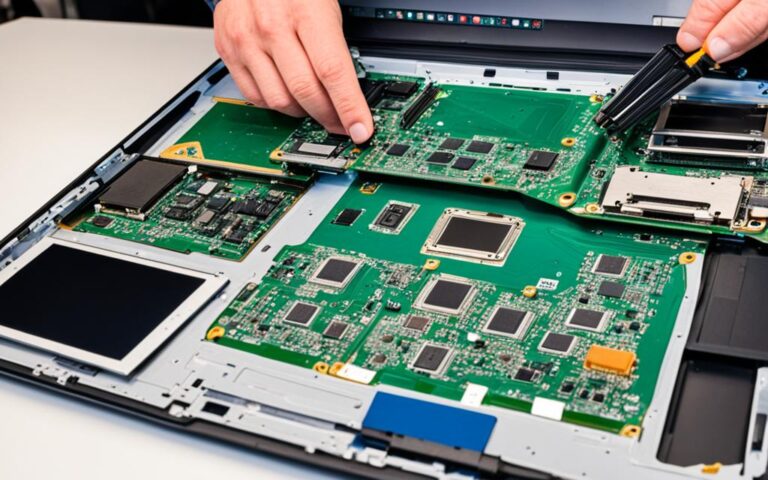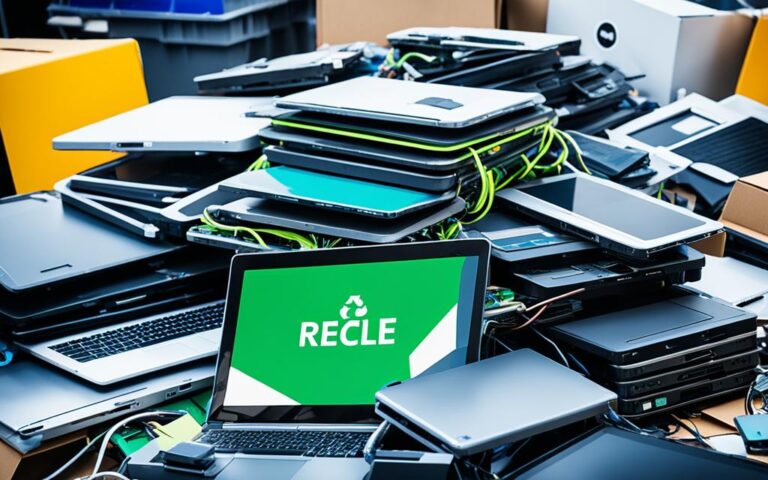Building a Sustainable Future Through Laptop Recycling
In today’s rapidly advancing digital age, the demand for laptops and other electronic devices is ever-increasing. However, this surge in technology comes with a downside: electronic waste, or e-waste. The improper disposal of laptops contributes to environmental degradation and poses significant threats to our planet’s health. Sustainable laptop recycling is the key to combating this issue and creating an eco-friendly tech disposal system that paves the way for a greener future.
As the UK’s tech industry flourishes, so does the volume of electronic waste generated from discarded laptops. These devices contain valuable materials that, if not recovered, can further harm the environment. Recycling laptops through sustainable practices not only reduces the environmental impact but also allows for the extraction and reuse of precious metals and rare earth elements.
By embracing innovative solutions and sustainable practices, we can revolutionize the way we dispose of laptops and empower the creation of a greener future. Through proper laptop recycling, we contribute to the circular economy by extending the lifespan of valuable materials and reducing the need for raw resource extraction. Additionally, by incorporating eco-friendly tech disposal methods, we mitigate the harmful effects of e-waste on the environment and ensure a sustainable path forward.
In the following sections, we will delve deeper into the growing issue of e-waste, the need for sustainable solutions, corporate responsibility in e-waste management, technological innovations, and the challenges we face. Together, let’s explore how we can make a difference and build a sustainable future through laptop recycling.
The Growing Issue of E-waste
E-waste, which includes discarded electronic devices like laptops, is a rapidly growing environmental concern. The global production of laptops is skyrocketing, with projections estimating a significant increase in shipments over the coming years. In the UK, the laptop market is thriving, but it also contributes to the mounting e-waste problem.
The discarded laptops are filled with valuable materials, often referred to as the hidden treasure within e-waste, such as precious metals, rare earth elements, and semiconductor chipsets. However, the current trend shows that only a small percentage of laptops undergo repair, leading to significant amounts of e-waste accumulating.
“The disposal of electronic waste poses a significant threat to our environment if not properly managed. We need to take action to reduce the growing e-waste problem and maximize the potential value of these discarded laptops.” – [Expert’s Name, Position, Organization]
In order to tackle this issue, it is essential to raise awareness about the environmental impact of e-waste and the potential value hidden within discarded laptops. By implementing sustainable practices and innovative solutions, we can transform the e-waste crisis into an opportunity for resource recovery and environmental preservation. In the next section, we will explore the need for sustainable solutions to address the growing e-waste problem.
The Need for Sustainable Solutions
To address the growing e-waste issue, sustainable solutions are required. Designing laptops with design for disassembly and repair in mind, implementing efficient recycling infrastructure, promoting remanufacturing practices, and advocating for the right to repair are crucial steps towards a more sustainable future.
By making laptops easily repairable, we can extend their lifespan and reduce the need for frequent replacements. This approach not only reduces e-waste but also saves resources and energy that would otherwise be spent on manufacturing new laptops.
Efficient recycling infrastructure plays a vital role in managing e-waste. Establishing proper collection systems and recycling facilities ensures that discarded laptops are handled responsibly. This includes dismantling and separating different components for recycling and recovering valuable materials like precious metals and rare earth elements.
Remanufacturing, or refurbishing, is another sustainable solution that helps reduce e-waste. By refurbishing laptops instead of disposing of them, we can give them a second life and save valuable resources. This process involves repairing and restoring laptops to their original condition, thereby extending their usability.
Advocacy for the right to repair is essential in promoting sustainability. The right to repair grants individuals the freedom to repair their own laptops or have them repaired by a technician of their choice. This not only saves money but also reduces e-waste by alleviating the need for premature disposal.
By implementing these sustainable solutions – design for disassembly and repair, efficient recycling infrastructure, remanufacturing, and the right to repair – we can reduce the environmental impact of e-waste and create a circular economy where resources are used efficiently and responsibly.
Benefits of Sustainable Solutions
| Sustainable Solution | Benefits |
|---|---|
| Design for Disassembly and Repair | – Extends the lifespan of laptops – Reduces the need for new laptop production – Reduces e-waste |
| Efficient Recycling Infrastructure | – Recovers valuable materials from discarded laptops – Reduces resource consumption |
| Remanufacturing | – Gives laptops a second life – Saves resources and energy – Reduces e-waste |
| Right to Repair | – Empowers individuals to repair their laptops – Reduces e-waste through repair instead of disposal |
Corporate Responsibility in E-waste Management
Businesses play a significant role in promoting sustainable e-waste management practices. By embracing corporate responsibility, companies can contribute to a more sustainable and responsible tech industry. This section explores the various ways businesses can take action and make a positive impact.
Implementing Green IT Initiatives
One of the key steps that businesses can take is implementing green IT initiatives. By using energy-efficient data centers and promoting responsible behaviors among employees, companies can reduce their environmental footprint. Green IT initiatives not only help in reducing energy consumption but also promote sustainable practices throughout the organization.
Adopting Corporate Sustainability Programs
Corporate sustainability programs are essential for reducing the environmental impact of e-waste. These programs focus on initiatives such as product durability and recycling partnerships with professional recycling companies. By designing products that last longer and can be easily repaired, companies can minimize the generation of e-waste. Additionally, partnerships with recycling companies ensure that the e-waste is disposed of responsibly and recycled efficiently.
Engaging in Responsible Recycling Practices
Responsible recycling practices are critical for businesses committed to corporate responsibility. By partnering with professional recycling companies that follow ethical and environmentally sound practices, companies can ensure that their e-waste is handled in a responsible manner. These partnerships help maximize the recovery of valuable materials from e-waste, reducing the need for new resource extraction and minimizing the environmental impact of disposal.
“Corporate responsibility is not just a moral obligation; it is also a business imperative. By taking proactive steps towards sustainable e-waste management, businesses can enhance their reputation, attract environmentally conscious customers, and create a positive impact on the planet.” – Emma Greenfield, Sustainability Consultant
Examples of Corporate Green IT Initiatives and Sustainability Programs
| Company | Green IT Initiatives | Sustainability Programs |
|---|---|---|
| Microsoft | Energy-efficient data centers, use of renewable energy | Microsoft Sustainability Initiative, Circular Center |
| Cloud computing to minimize energy consumption | Google Sustainability Labs, Circular Economy Leadership Coalition | |
| Apple | Design for disassembly and recyclability | Apple Renew, Supplier Responsibility Program |
These examples demonstrate the commitment of leading companies to incorporate sustainability into their operations. By implementing similar initiatives and programs, companies can make a significant difference in reducing the environmental impact of e-waste.
Corporate responsibility is not limited to large corporations; every business can contribute to sustainable e-waste management. By adopting green IT initiatives, implementing sustainability programs, and engaging in responsible recycling practices, companies of all sizes can make a positive impact on the environment and build a more sustainable future.
Technological Innovations in E-waste Management
Technological innovations are playing a crucial role in driving advancements in e-waste management, revolutionizing the way we handle electronic waste. With the rapid growth of the tech industry and the increasing volume of e-waste, innovative solutions are needed to streamline the recycling process and ensure a more sustainable future.
Blockchain technology is one such innovation that has the potential to transform e-waste management. By leveraging the power of blockchain, we can create a transparent and accountable system for tracking e-waste throughout its lifecycle. This technology ensures that each step, from collection to recycling, is recorded and verified, promoting responsible disposal practices and minimizing the risk of illegal dumping. The use of blockchain not only enhances transparency but also instills trust among stakeholders, facilitating collaboration and efficient management of e-waste.
Anothe technologicallyautomated sorting systems powered by artificial intelligence are revolutionizing the recycling process. These cutting-edge systems use advanced algorithms and machine learning capabilities to identify and separate different types of e-waste efficiently. By automating the sorting process, recycling facilities can significantly increase their productivity and accuracy, leading to higher recovery and recycling rates. Automated sorting systems also minimize the amount of waste sent to landfill, reducing the environmental impact of e-waste disposal.
These technological innovations bring us closer to achieving a more sustainable e-waste management system. By harnessing the power of blockchain technology and automated sorting systems, we can ensure transparency, accountability, and efficiency in the recycling process, contributing to a greener future.
| Advantages of Technological Innovations in E-waste Management | |
|---|---|
| Transparent tracking of e-waste throughout its lifecycle | Minimizes the risk of illegal dumping and promotes responsible disposal |
| Improved accuracy and efficiency in sorting e-waste | Increases recovery and recycling rates |
| Reduces the environmental impact of e-waste disposal | Contributes to a more sustainable future |
Challenges and Future Considerations
Despite the efforts towards sustainable e-waste management, various challenges persist. These challenges encompass the complexity of electronic products, lack of infrastructure, lack of awareness, and wrong public perceptions.
Product Complexity
The complexity of electronic products, including the intricate design and integration of various components, presents a significant challenge in the recycling process. Material separation and sorting become increasingly difficult, making it harder to recover valuable materials while ensuring proper disposal of hazardous substances.
Lack of Infrastructure
Inadequate infrastructure in many regions poses a major hindrance to proper e-waste management. Insufficient recycling facilities, collection points, and transportation networks result in limited access and capacity for effective recycling and disposal. This lack of infrastructure further exacerbates the e-waste problem, leading to improper handling and disposal of hazardous materials.
Lack of Awareness
A notable challenge in sustainable e-waste management is the lack of awareness among the public. Many individuals are unaware of the environmental implications of e-waste and the importance of responsible disposal. This lack of awareness contributes to the improper disposal of electronic devices, preventing valuable materials from being recovered and adding to the growing e-waste volume.
Wrong Public Perceptions
Another challenge stems from the misconceptions surrounding the quality of recycled products. Some members of the public have negative perceptions about the performance and reliability of recycled electronic devices. These misconceptions may discourage individuals from participating in e-waste recycling programs and hinder the adoption of circular economy principles.
“The challenges in sustainable e-waste management require collaboration and continued efforts to educate and engage individuals, businesses, and governments. Through awareness campaigns, infrastructure development, and product innovation, we can overcome these obstacles and pave the way for a greener future.”
Future Considerations
Educational Initiatives
To address the lack of awareness surrounding e-waste, educational initiatives should be implemented to inform the public about the environmental impact of improper disposal. These initiatives can include awareness campaigns, educational programs in schools, and informative materials highlighting the importance of responsible e-waste management.
Infrastructure Development
Investment in infrastructure development is crucial for effective e-waste management. This includes the establishment of recycling facilities, collection centers, and convenient drop-off points for electronic devices. Additionally, improvements in transportation networks and logistics are necessary to facilitate the proper handling and disposal of e-waste.
Product Design and Innovation
Product design and innovation play a vital role in overcoming the challenges associated with e-waste. Designing electronic devices with easily recyclable materials and modular components can streamline the recycling process. Furthermore, promoting repairability and implementing product take-back programs can extend the lifecycle of electronic devices and reduce the overall volume of e-waste generated.
Regional Challenges in E-waste Management
| Region | Product Complexity | Lack of Infrastructure | Lack of Awareness | Wrong Public Perceptions |
|---|---|---|---|---|
| Europe | High | Medium | Medium | Low |
| North America | Medium | High | Low | Medium |
| Asia | High | High | Medium | Medium |
| Africa | Medium | Low | High | High |
| Australia | Medium | Medium | Medium | Medium |
The challenges in e-waste management vary across different regions. Factors such as product complexity, lack of infrastructure, awareness levels, and public perceptions contribute to the unique challenges faced. Understanding these regional differences is essential for implementing targeted strategies that can effectively address the specific obstacles in each area.
Conclusion
Sustainable e-waste management is essential for creating a greener and more sustainable future. To achieve this, we must embrace sustainable practices such as design for disassembly and repair, implement efficient recycling infrastructure, and promote responsible behaviors. By adopting these strategies, we can significantly reduce the environmental impact of e-waste and contribute to the development of a circular economy.
Collaboration between individuals, businesses, and governments is crucial in tackling the challenges associated with e-waste management. By working together, we can address the complexity of electronic products, improve recycling infrastructure, raise awareness about the environmental implications of e-waste, and debunk misconceptions about recycled products.
Building a sustainable future through laptop recycling requires our collective effort. By prioritizing sustainable e-waste management practices, we can create a greener tomorrow. Let us join forces and make a difference by embracing sustainable practices and contributing to a circular economy that protects our environment and paves the way for a brighter future.
FAQ
Why is sustainable laptop recycling important?
Sustainable laptop recycling is important because it is a crucial part of building a more sustainable future. The UK’s tech industry is growing, leading to an increase in electronic waste, particularly from discarded laptops. If not properly managed, this e-waste poses a significant environmental threat. By embracing sustainable practices and innovative solutions, we can revolutionize eco-friendly tech disposal and work towards creating a greener future.
What is e-waste and why is it a growing concern?
E-waste refers to discarded electronic devices like laptops. It is a rapidly growing environmental concern due to the skyrocketing global production of laptops. The UK laptop market is thriving, but it also contributes to the mounting e-waste problem. Discarded laptops contain valuable materials, often referred to as the hidden treasure within e-waste, such as precious metals, rare earth elements, and semiconductor chipsets. However, only a small percentage of laptops undergo repair, leading to significant amounts of e-waste accumulating.
What are the sustainable solutions to address the e-waste issue?
Sustainable solutions to address the e-waste issue include designing laptops with repairability in mind, implementing efficient recycling infrastructure, promoting remanufacturing practices, and advocating for the right to repair. By making laptops easily repairable, extending their lifespan, and recovering valuable materials through recycling and remanufacturing, we can reduce the environmental impact of e-waste and create a circular economy.
How can businesses contribute to sustainable e-waste management?
Businesses can contribute to sustainable e-waste management by implementing green IT initiatives, such as using energy-efficient data centers and promoting responsible behaviors among employees. Adopting corporate sustainability programs that focus on reducing the environmental impact of e-waste through initiatives like product durability and recycling partnerships with professional recycling companies is also essential.
What are the technological innovations in e-waste management?
Technological innovations in e-waste management include the use of blockchain technology to track e-waste throughout its lifecycle, ensuring transparency and accountability. Automated sorting systems powered by artificial intelligence are also revolutionizing the recycling process, making it more efficient and effective. These innovations help streamline e-waste management and contribute to higher recovery and recycling rates.
What are the challenges and future considerations in e-waste management?
The challenges in e-waste management include the complexity of electronic products, making material separation and sorting difficult. Inadequate infrastructure in many regions hinders proper e-waste management. Moreover, lack of awareness among the public about the environmental implications of e-waste and misconceptions about the quality of recycled products further complicate the situation. Overcoming these challenges requires collaboration and continued efforts to educate and engage individuals, businesses, and governments.
Why is sustainable e-waste management important?
Sustainable e-waste management is crucial for building a greener and more sustainable future. By embracing sustainable practices like design for disassembly and repair, implementing efficient recycling infrastructure, and promoting responsible behaviors, we can reduce the environmental impact of e-waste and create a circular economy. Collaboration between individuals, businesses, and governments is necessary to tackle the challenges associated with e-waste and pave the way for a greener tomorrow.

